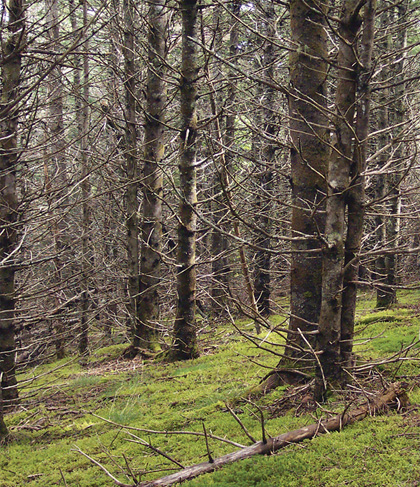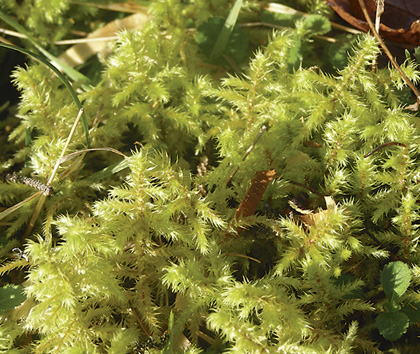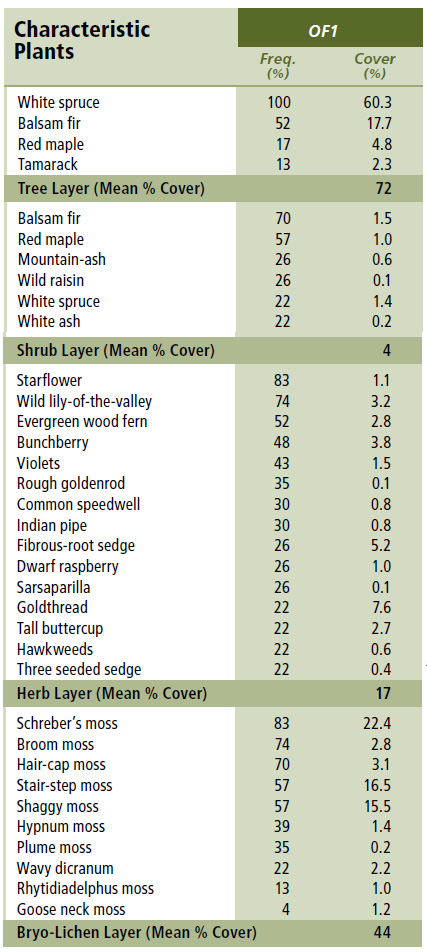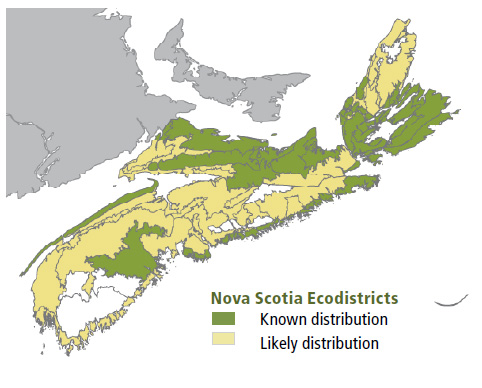
Forest Vegetation types - OF1
OF1 — White spruce / Aster – Goldenrod / Shaggy moss
Picea glauca / Aster spp. – Solidago spp. / Rhytidiadelphus triquetrus
 |
Farmville, Lunenburg County |
Concept: This early successional Vegetation Type (VT) has abundant white spruce, often with a minor component of balsam fir. OF1 stands usually develop closed overstory canopies resulting in needle carpet and/or moss-dominated forest floors with minimal shrub and herb cover. OF1 represents the dominant softwood forest associated with abandoned agricultural lands in central and eastern Nova Scotia.
Vegetation: White spruce is the dominant overstory tree. Common associates include balsam fir, red maple and tamarack. Both the shrub and herb layers can be species rich, but they are usually poorly developed. Hawkweeds, goldenrods, asters and several grass species are indicative of past agricultural land-use. Other common, but seldom abundant, species include strawberry, common speedwell, tall buttercup and bedstraws. Moss cover can be variable and interspersed with needle carpet. Where present, species include shaggy moss, Schreber's moss, broom moss, hair-cap moss and stair-step moss.
Environmental Setting: OF1 is mainly associated with fresh to fresh-moist, nutrient medium to rich soils of variable texture. This VT is found throughout Nova Scotia, but is primarily associated with several Nova Scotia Upland ecodistricts (Cobequid Hills, Cobequid Slopes, Cape Breton Hills, Pictou Antigonish Highlands) and the Atlantic Coastal and Fundy Shore ecoregions. Sites that have been tilled or pastured have level micro-topography and a distinct Ap (plough layer) soil horizon.
Successional Dynamics: OF1 is an even-aged, early successional VT dominated by white spruce. Although white spruce has the ability to regenerate grassy microsites, old field trees tend to have a shorter lifespan than those found in natural forest conditions. They also do not re-establish under their own cover, which inevitably leads to ecosystem collapse. Natural disturbance agents include insects (e.g. bark beetles, tussock moth, spruce budworm) and windthrow. Subsequent successional stages usually include species indicative of pre-agricultural forest cover, especially if such seed sources are nearby. Stands that slowly deteriorate are more likely to succeed to such forest conditions as shade-tolerant species regenerate on site. Clearcut harvesting may initiate an earlier successional stage dominated by grey birch, pin cherry, aspen, white birch and/or other woody shrubs. Depending in part on the level of advanced regeneration at time of harvest, OF1 may also succeed to OF4 (Balsam fir –White spruce / Evergreen wood fern – Wood aster) or other VTs dominated by shade-intolerant species such as white birch, aspen and red maple. As many OF1 sites were originally tolerant hardwood sites, later successional stages are likely to include a component of sugar maple, yellow birch and/or beech, possibly leading to TH1 (Sugar maple / Hay-scented fern) or TH2 (Sugar maple / New York fern – Northern beech fern).
Ecological Features: Past cultivation across this patch forest has leveled most pre-disturbance micro topography, while rock walls and piles, old foundations and wells provide additional evidence of agricultural land use. Linear rock piles may provide habitat for small cavity dwellers including rodents, snakes, and ground dwelling insects like wasps and bees. Other unique aspects include the forest's close proximity to open fields and active farms and the frequent presence of apple and other fruit trees. These features may attract deer, red fox, coyotes, red squirrels, small mammals, and birds including ruffed grouse, thrushes, crows and blue jays. OF1 provides excellent growing conditions for mycorrhizal mushrooms such as chanterelle and boletes, which are allied with spruce. Although these forests add to landscape structural diversity, they have a simplified ecological make-up, reflected by low tree diversity, structural complexity, and deadwood volume. Mature forests are highly susceptible to spruce bark beetle attack, leading to their rapid collapse.
 |
| Shaggy moss |
Distinguishing Features: This softwood forest on well drained soils is extensively white spruce. Rock foundations, rock piles, rock walls and wire fencing are indicators of past agricultural use. Level microtopography and a soil profile that shows a plough layer are good site indicators. Dense stands have poorly developed herb and moss layers.
| Slope Position: | Lower4 Level2 Middle2 Upper2 |
Surface Stoniness: |
(Non-rocky)9 (Slightly - Moderately)1 |
Bedrock Outcrop: |
(Non-rocky)9 (Slightly - Moderately)1 |
Elevation Range: |
9 - 310m |
Slope Gradient: |
Gentle5 Level2 Moderate2 Strong1 |
Aspect: |
North1 East2 South2 West2 None2 nd1 |
Exposure: |
Moderate4 Mod. exposed3 Exposed2 Mod. sheltered1 |
Microtopography: |
Level7 Moderate1 Slightly1 Other1 |
Drainage: |
Well6 Imperfect2 Moderately well2 |
Soil Type: |
ST85 ST2-L2 ST91 ST111 Other1 |
Parent Material: |
Glacial till10 |
Rooting Depth (cm): |
(<30)2 (30-45)3 (>45)5 |
Duff Thickness (cm): |
(0-5)4 (6-10)4 (11-20)1 nd1 |

